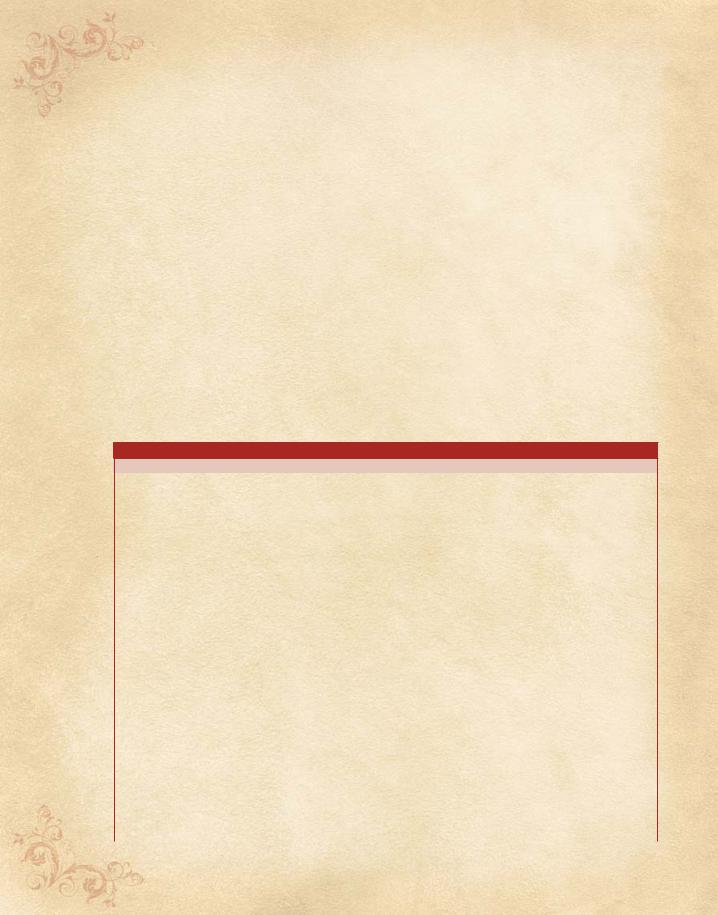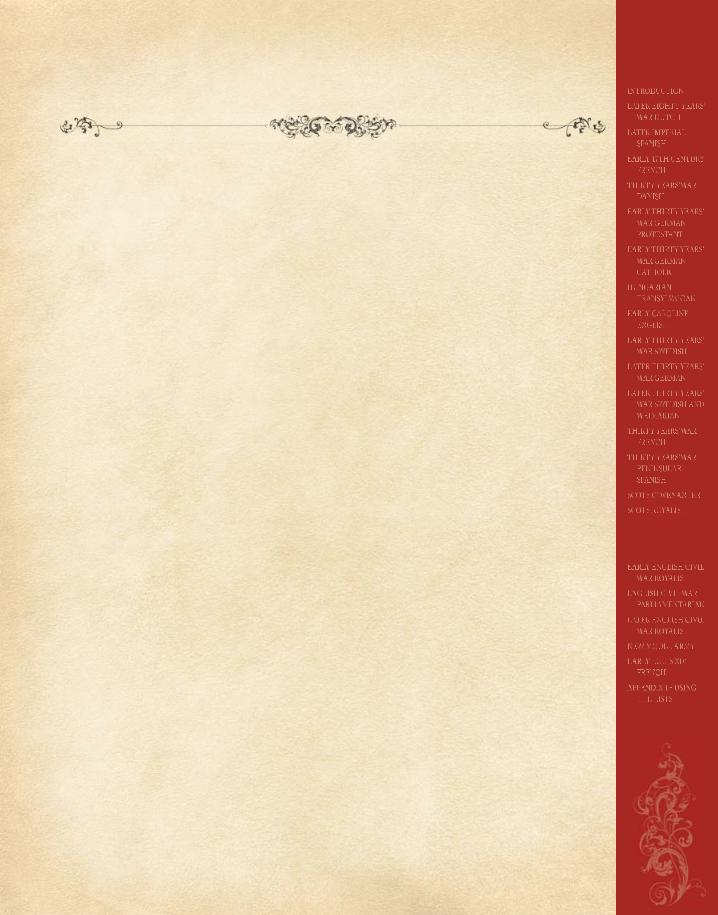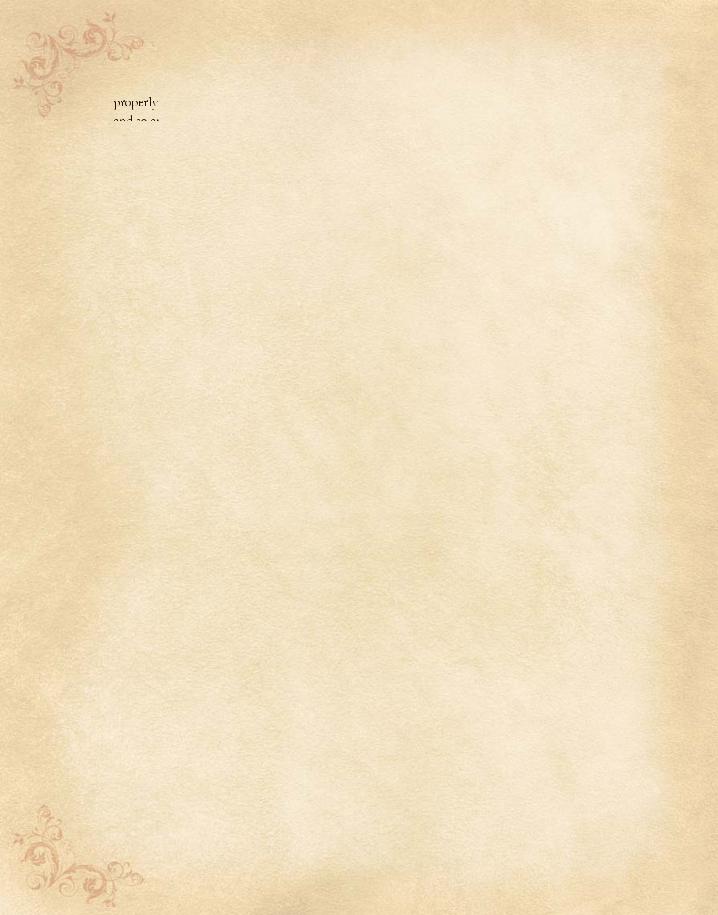
- •INTRODUCTION
- •LATER EIGHTY YEARS’ WAR DUTCH
- •LATER IMPERIAL SPANISH
- •EARLY 17TH CENTURY FRENCH
- •THIRTY YEARS’ WAR DANISH
- •EARLY THIRTY YEARS’ WAR GERMAN PROTESTANT
- •HUNGARIAN-TRANSYLVANIAN
- •EARLY CAROLINE ENGLISH
- •EARLY THIRTY YEARS’ WAR SWEDISH
- •LATER THIRTY YEARS’ WAR GERMAN
- •LATER THIRTY YEARS’ WAR SWEDISH AND WEIMARIAN
- •THIRTY YEARS’ WAR FRENCH
- •THIRTY YEARS’ WAR PENINSULAR SPANISH
- •SCOTS COVENANTER
- •SCOTS ROYALIST
- •EARLY RESTORATION PORTUGUESE
- •CONFEDERATE IRISH
- •EARLY ENGLISH CIVIL WAR ROYALIST
- •ENGLISH CIVIL WAR PARLIAMENTARIAN
- •LATER ENGLISH CIVIL WAR ROYALIST
- •NEW MODEL ARMY
- •EARLY LOUIS XIV FRENCH
- •APPENDIX 1 – USING THE LISTS
- •INDEX

EARLY RESTORATION PORTUGUESE
EARLY RESTORATION PORTUGUESE
As a result of the financial burdens of the ongoing Spanish involvement in the Thirty Years’War, the Spanish government raised
taxation levels on the Portuguese, despite Portugal being theoretically a separate state, although sharing the same king. Eventually this proved too much for the Portuguese and they rose in rebellion, proclaiming João, Duke of Braganza, their king as João IV.
Although Portugal was a small country compared to the Spanish empire, the Spanish, involved as they were with the war with France, were in no position to commit major forces to crush the rebellion. As a result the war proceeded in a rather desultory fashion, with only one real battle in this period, Montijo in 1644. Although this went badly for the Portuguese, with so few troops available the Spanish were unable to follow up their victory.
This list covers Portuguese armies from the beginning of the War of Restoration until the signature of the Treaty of the Pyrenees in 1659 allowed Spain to re-focus on defeating the Portuguese rebellion.
TROOP NOTES
The first Portuguese infantry units raised in 1640 followed the Spanish Tercio model. They first consisted of 10 Tercios, each with a theoretical strength of 2,000 men: 700 pike, 400 musketeers, 790 arquebusiers and 110 officers. Later the proportion of musketeers was increased, while the total size of each unit was downsized to a theoretical strength of around 1,500 men: 480 pike, 720 musketeers, 300 arquebusiers plus officers. However, in the only major pitched battle of the period (Montijo, 1644), the Portuguese
actually deployed regiments of around 600 men in standard pike and shot formations following the Dutch or French model, thus we do not give Portuguese battle groups tercio abilities.
Portuguese cavalry were also organised along the lines of their Spanish counterparts, but was considered to be inferior to that of their foes. Probably owing to that, Portuguese infantry regiments initially had quite a high proportion of pike in comparison to the Spanish (although not enough to justify a different representation), and made extensive use of chevaux-de-frise to deter the Spanish cavalry.
Foreign regiments represent the troops sent by other European powers to support the Portuguese front, such as the Dutch present at Montijo.
Portuguese forces were mostly based in the castles and fortresses along the Spanish border, from where they conducted a skirmishing war based on raids against the Spanish positions.
Field guns in action
77
© Osprey Publishing ¥ www.ospreypublishing.com
SCOTS ROYALIST
EARLY RESTORATION
PORTUGUESE

|
|
|
WARS OF RELIGION |
||
|
|
|
|||
EARLY RESTORATION PORTUGUESE STARTER ARMY |
|||||
Commander-in-Chief |
1 |
|
Field Commander |
|
|
Sub-Commanders |
2 |
|
2 x Troop Commander |
||
Cuirassiers |
2 |
BGs |
Each comprising 4 bases of cuirassiers: Average, Armoured, Horse – Impact |
||
Pistol, Melee Pistol |
|
||||
|
|
|
|
||
Arquebusiers |
2 |
BGs |
Each comprising 4 bases of arquebusiers: Average, Armoured, Horse – |
||
Carbine, Melee Pistol |
|||||
|
|
|
|||
Portuguese tercios |
3 |
BGs |
Each comprising 6 bases of Portuguese tercios: 2 Average, Armoured, Heavy |
||
Foot – Pike; and 4 Average, Unarmoured, Medium Foot – Musket |
|||||
|
|
|
|||
Foreign regiments |
2 |
BGs |
Each comprising 6 bases of foreign regiments: 2 Average, Unarmoured, Heavy |
||
Foot – Pike; and 4 Average, Unarmoured, Medium Foot – Musket |
|||||
|
|
|
|||
Dragoons |
1 BG |
4 bases of dragoons: Average, Unarmoured, Dragoons – Musket |
|||
Dragoons |
1 |
BG |
3 bases of dragoons: Average, Unarmoured, Dragoons – Musket |
||
Field guns |
1 |
BG |
2 bases of field guns: Average Medium Artillery – Medium Artillery |
||
Camp |
1 |
|
Unfortified camp |
|
|
Total |
12 BGs |
Camp, 16 mounted bases, 39 foot bases, 3 commanders |
|||
BUILDING A CUSTOMISED LIST |
• Commanders should be depicted as |
||||
USING OUR ARMY POINTS |
cuirassiers. |
||||
Choose an army based on the maxima and minima in the list below. The following special instructions apply to this army:
•Portuguese tercios do not count as tercios as defined in the rule book.
EARLY RESTORATION PORTUGUESE
Territory Types: Agricultural
C-in-C |
|
Great Commander/Field Commander/Troop Commander |
80/50/35 |
|
1 |
|
||||||||
Sub-commanders |
|
|
|
Field Commander |
|
|
|
50 |
|
|
0–2 |
|||
|
|
|
Troop Commander |
|
|
|
35 |
|
|
0–3 |
||||
|
|
|
|
|
|
|
|
|
||||||
Troop name |
|
|
Troop Type |
|
Capabilities |
|
Points |
Bases |
Total |
|||||
|
Type |
|
Armour |
Quality |
Shooting |
Combat |
|
Melee |
per base |
per BG |
bases |
|||
|
|
|
|
|||||||||||
|
|
|
|
|
|
|
|
|
|
|
|
|
|
|
|
|
|
|
Core |
Troops |
|
|
|
|
|
|
|
|
|
|
|
Horse |
|
Heavily |
Average |
– |
Pistol |
|
Pistol |
12 |
|
4 |
|
|
Cuirassiers |
|
|
Armoured |
|
|
0–12 |
||||||||
|
|
|
|
|
|
|
|
|
|
|
|
|||
|
|
Horse |
|
Armoured |
Average |
– |
Pistol |
|
Pistol |
10 |
|
4 |
|
|
Arquebusiers |
|
Horse |
|
Armoured |
Average |
Carbine |
– |
|
Pistol |
11 |
|
4 |
4–8 |
|
|
|
Unarmoured |
|
9 |
|
|||||||||
|
Only before |
Medium foot |
Unarmoured |
Average |
Arquebus |
– |
|
– |
7 |
4 |
|
6 |
|
|
Portuguese tercios |
1645 |
Heavy Foot |
|
Armoured |
Average |
– |
Pike |
|
Pike |
6 |
2 |
|
18–72 |
|
|
|
|
|
|||||||||||
Only from |
Medium foot |
Unarmoured |
Average |
Musket |
– |
|
– |
8 |
4 |
|
6 |
|||
|
|
|
|
|||||||||||
|
1645 |
Heavy foot |
|
Armoured |
Average |
– |
Pike |
|
Pike |
6 |
2 |
|
|
|
|
|
|
|
|
|
|||||||||
Field guns |
|
Medium |
|
– |
Average |
Medium |
– |
|
– |
20 |
2, 3 or 4 |
2–4 |
||
|
Artillery |
|
Artillery |
|
||||||||||
|
|
|
|
Optional |
Troops |
|
|
|
|
|
|
|
|
|
Newly raised |
Only before |
Medium foot |
Unarmoured |
Poor |
Arquebus |
– |
|
– |
5 |
4 |
|
6 |
|
|
1645 |
Heavy foot |
|
Armoured |
Poor |
– |
pike |
|
pike |
4 |
2 |
|
|
||
Portuguese tercios |
|
|
|
|
|
|
|
|
|
|
|
|
|
0–48 |
Only from |
Medium foot |
Unarmoured |
Poor |
Musket |
– |
|
– |
6 |
4 |
|
|
|||
and militia |
|
|
6 |
|
||||||||||
1645 |
Heavy foot |
|
Armoured |
Poor |
– |
Pike |
|
Pike |
4 |
2 |
|
|
||
|
|
|
|
|
|
|||||||||
Foreign regiments |
|
Medium foot |
Unarmoured |
Average |
Musket |
– |
|
– |
8 |
4 |
|
6 |
0–18 |
|
|
Heavy foot |
|
Unarmoured |
Average |
– |
Pike |
|
Pike |
5 |
2 |
|
|||
|
|
|
|
|
|
|
||||||||
Dragoons |
|
Dragoons |
|
Unarmoured |
Average |
Musket |
– |
|
– |
8 |
3 or 4 |
0–6 |
||
Chevaux-de-frise to cover half the |
Portable |
|
– |
– |
– |
– |
|
– |
3 |
|
|
|
Any |
|
bases of each Portuguese tercio |
Defences |
|
|
|
|
|
||||||||
|
|
|
|
|
|
|
|
|
|
|
|
|||
78
© Osprey Publishing ¥ www.ospreypublishing.com

CONFEDERATE IRISH
CONFEDERATE IRISH
Ireland was, as always, very much the odd one out of the three Stuart kingdoms ruled by Charles I. The most obvious difference was
that the majority of the population were Catholic, but thanks to a long series of English laws, were second class citizens because of this. Additionally, those very same laws had been enacted to encourage English settlers to move to Ireland and effectively to dispossess the Catholic population. Thus, hopefully, Ireland would eventually be turned into a Protestant kingdom. To add extra spice to the mix there were, in Ulster, a significant number of Presbyterian Scottish settlers, who naturally looked to their homeland for protection in times of trouble.
By 1641 the various pressures on the Irish proved too much and a rebellion broke out. The Irish organised themselves under the Irish Catholic Confederation, also known as the Confederation of Kilkenny after the city where it was based.They organised the rebels into military districts which were responsible for providing a number of troops for a combined “marching army”, and additional troops for “home defence” of each region. Inevitably, the rebellion forced an English reaction, with a new army being raised in England for service in Ireland, but it also forced a reaction in Scotland, where a force of 10,000 men was despatched by the Covenanter government to Ulster for the protection of the Scots settlers.
The initial stages of the resulting war saw little in the way of pitched battles, and what there were went against the Irish.The majority of the fighting was of the “small war”variety, where the traditional hit and run tactics of the Irish once again proved effective and dragged the conflict on and on.
By late 1643, with the civil war turning against him, Charles ordered the Duke of Ormonde, his commander in Ireland, to organise a cessation of hostilities and the shipping to England of as many troops as possible to fight in his armies. This was done, and the war entered a stalemate.
The Irish cause was reinvigorated in 1645 by the arrival of Giovanni Battista Rinuccini, the Papal nuncio,with arms and money to encourage Catholic resistance against the Protestant English and Scots. His backing of more militant Confederates, such as Owen Roe O’Neill, ensured the continuation of the war. However, this also coincided with the winding down of hostilities in England, which allowed the English Parliament to send reinforcements to the forces loyal to them in Ireland.
Finally, in 1649, the English Parliament dispatched a high quality force from the New Model army, led by Oliver Cromwell, to finish the Irish war. This he did efficiently, although also with some brutality as the massacres at Drogheda and Wexford show.
This list covers Irish armies of the Confederation of Kilkenny from the outbreak of the rebellion in 1641 until their final defeat by the English Commonwealth in 1652. It includes Ormond’s coalition army of 1648–50, comprised of a bizarre alliance of Confederate Irish, Irish and English Royalists and Presbyterian Ulster Scots.
TROOP NOTES
Whilst Irish foot were supposed to be organised into conventional regiments, modern weapons were in short supply and many were equipped in a more traditional manner and fought as they had for centuries.Those regiments that were equipped
79
© Osprey Publishing ¥ www.ospreypublishing.com
EARLY RESTORATION
PORTUGUESE
CONFEDERATE IRISH

WARS OF RELIGION
still suffered from a shortage of firearms are classified as Musket* – in fact even this
may be a touch generous.
Irish horse were few in number and relatively ineffective, even being afraid of the fairly weak Scottish cavalry – asking for armour before they
would be willing to fight them on one occasion. However, the cavalry of the coalition army of Ormond appears to have been both more numerous and of higher quality, even being able to stand up to the veteran English Commonwealth horse for a short time on occasion.
|
CONFEDERATE IRISH STARTER ARMY |
||||
Commander-in-Chief |
|
1 |
|
Field Commander |
|
Sub-Commanders |
|
2 |
|
2 x Troop Commander |
|
Irish Horse |
|
1 |
BG |
4 bases of Irish horse: Poor, Unarmoured, Horse – Shooting Pistol, |
|
|
Swordsmen |
|
|||
|
|
|
|
|
|
Irish Horse |
|
2 |
BGs |
Each comprising 4 bases of Irish horse: Average, Unarmoured, Determined |
|
|
Horse – Impact Pistol, Melee Pistol |
||||
|
|
|
|
||
Irish Foot |
|
4 |
BGs |
Each comprising 6 bases of Irish foot: 2 Average, Unarmoured, Heavy Foot – |
|
|
Pike; and 4 Average, Unarmoured, Medium Foot – Musket* |
||||
|
|
|
|
||
Irish Foot |
|
1 |
BG |
8 bases of Irish foot: Average, Unarmoured, Warriors – Light Spear |
|
“Redshanks” |
|
2 |
BGs |
Each comprising 8 bases of “Redshanks”: Average, Unarmoured, Warriors – |
|
|
Bow*, Impact Foot, Swordsmen |
||||
|
|
|
|
||
Skirmishing Shot |
|
2 |
BGs |
Each comprising 4 bases of skirmishing shot: Average, Unarmoured, Light |
|
|
Foot – Musket |
|
|||
|
|
|
|
|
|
Camp |
|
1 |
|
Unfortified camp |
|
Total |
|
12 BGs |
Camp, 12 mounted bases, 56 foot bases, 3 commanders |
||
BUILDING A CUSTOMISED LIST |
• Commanders should be depicted as Irish |
||||
USING OUR ARMY POINTS |
Horse. |
||||
Choose an army based on the maxima and minima in the list below. The following special instructions apply to this army:
80
© Osprey Publishing ¥ www.ospreypublishing.com
